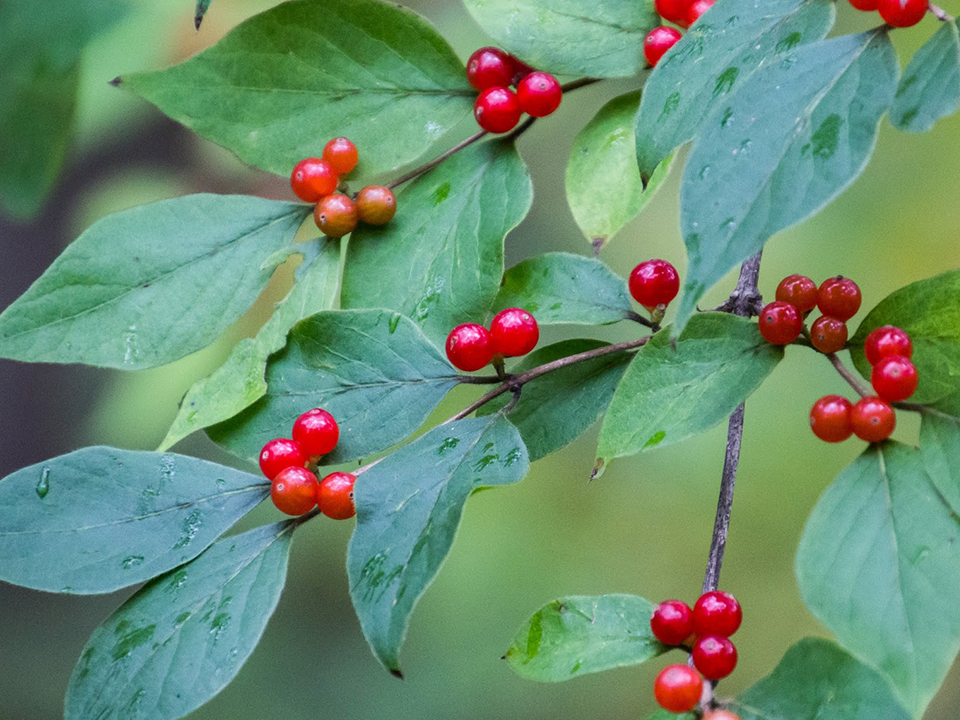
Flower clusters of Amur honeysuckle in spring.
Species Name: Lonicera maakii
Common Name: Amur Honeysuckle
Origin: native to northern and western China, Mongolia and Korea
Distribution: Grows throughout the eastern United States west to the plains states.it will grow in any disturbed habitat from old fields , road sides and the understory of woodlands. It is especially problematic in the mid-Atlantic and southern states. Although it is seldom offered for sale and is not widely planted today it continues to spread from naturalized populations and is locally abundant.
Identification: A large shrub typically growing 6 to 10ft tall but can reach 15 to 20ft. Usually multi-stemmed with long arching branches. Leaves are opposite aligned in a flattened arrangement along the stem. Stems tend to be leggy having fewer lateral branches and forking than other Asian honeysuckles. White flowers in pairs produced in late spring. Small dark red fruits develop in single or double pairs in the axil of the leaf in fall. Fruits persist into late fall and winter. No significant fall color normally a yellowish green.
Diagnostic characteristics:
One of the first plants to leaf out in the spring and last to drop its leaves in the fall.
Paired fragrant white flowers in late spring.
Dark red fruits arrange in paired clusters of 4 fruits in late summer remaining into winter. The other Asian honeysuckles produce their fruit in mid-summer and do not last into fall.
Biology and Spread: Amur honeysuckle is adaptable to wide range of soil and light conditions allowing it to grow is nearly any environment. It will grow in full sun to deep shade
Ecological threats: Amur honeysuckle is especially problematic in the understory of woodlands, invading and outcompeting native flora. It is a prolific seed producer and has a high capacity to establish and spread in the shade. It has no natural insect pests or diseases and is seldom eaten by deer or other herbivores. The fruit remain on the plant into winter when few other fruit is present which encourages birds to consume the fruit and disperse the seed.
Control methods:
1) Cut Stump Treatment:
Cut stump treatment is the preferred method for controlling medium to large honeysuckle. A brush saw is the most efficient tool for cutting large numbers of honeysuckle. A light weight chain saw may be used on larger stems as well. Each cut stem needs to be treated with a herbicide to prevent resprouting. A 10% to 15% solution of glyphosate (the active ingredient in Round-up) is applied to the cut surface. A hand held spray bottle works well for applying the herbicide to the cut stem. Add a spray colorant to the bottle so you can tell which stems have been treated.
2) Foliar treatments
A foliar spray may be used where there are large numbers of small seedlings and plants but generally is not recommended for controlling larger plants.
3) Manual Control
Pulling of honeysuckle can be used on small to medium plants or seedlings as the root system is not very vigorous. A weed wrench may be use to pull a few plants but the multi-stemmed nature of the plant may be prevent getting a good grip. Uprooting plants by digging, using a shovel or mattock can be used in loose sandy or gravely soils.

Flower clusters of Amur honeysuckle in spring.

Foliage and fruit of Amur honeysuckle

Fruits are in clusters of 2 to 4 in the axil of the leaf. Fruit remain on the plant into winter

Amur honeysuckle is large sprawling shrub.

Note multiple long slender stems and light brown bark